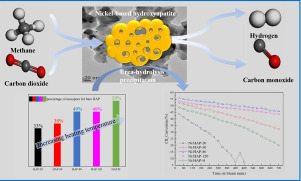当前位置:
X-MOL 学术
›
Fuel Process. Technol.
›
论文详情
Our official English website, www.x-mol.net, welcomes your
feedback! (Note: you will need to create a separate account there.)
Impact of pore structure on hydroxyapatite supported nickel catalysts (Ni/HAP) for dry reforming of methane
Fuel Processing Technology ( IF 7.2 ) Pub Date : 2020-06-01 , DOI: 10.1016/j.fuproc.2020.106359 Bin Li , Xiaoqing Yuan , Baitao Li , Xiujun Wang
Fuel Processing Technology ( IF 7.2 ) Pub Date : 2020-06-01 , DOI: 10.1016/j.fuproc.2020.106359 Bin Li , Xiaoqing Yuan , Baitao Li , Xiujun Wang

|
Abstract The hierarchical supports have motivated intensive research interests of chemists in the catalytic field because of the rational combination of mass transport property and large surface area. In this work, hydroxyapatite (HAP) supported nickel catalysts were prepared and employed to promote the dry reforming of methane (DRM). The proportion of mesopore/macropore in HAP was adjusted by the heating temperature (20, 50, 80, 120 °C) during the preparation process. The pore structure played an important role in regulating the physiochemical properties and thus affecting the catalytic performance in DRM. With increasing the proportion of mesopore on HAP, Ni preferentially dispersed on mesopore channel to form small-size particles. All catalysts possessed weak interaction between Ni nanoparticles and HAP; however, the interaction enhanced gradually with decreasing the Ni particles diameter. High proportion of macropore led to large-size Ni nanoparticle, while high proportion of small-size mesopore at 2–5 nm resulted in the complete blockage of these pore structures. These two boundary situations led to relatively weak interaction between nickel particles and the support, low metal dispersion and hence low activity as well as rapid deactivation in the DRM evaluation. Ni nanoparticles on HAP-80 and HAP-120 supports possessed relatively higher dispersion, which imparted these two catalysts with the function of strong anti-sintering ability and carbon resistance, thereby exhibiting better catalytic activity and stability in DRM evaluation. The deactivation of all catalysts during the reforming reaction was mainly ascribed to the sintering as well as encapsulation of Ni nanoparticles by graphitic carbon.
中文翻译:

孔结构对羟基磷灰石负载镍催化剂(Ni/HAP)用于甲烷干重整的影响
摘要 由于传质性质和大表面积的合理结合,分级载体激发了催化领域化学家的研究兴趣。在这项工作中,羟基磷灰石 (HAP) 负载的镍催化剂被制备并用于促进甲烷的干重整 (DRM)。制备过程中通过加热温度(20、50、80、120℃)调节HAP中介孔/大孔的比例。孔结构在调节理化性质方面起着重要作用,从而影响 DRM 中的催化性能。随着HAP上介孔比例的增加,Ni优先分散在介孔通道上形成小尺寸颗粒。所有催化剂在Ni纳米颗粒和HAP之间都具有弱相互作用;然而,随着Ni颗粒直径的减小,相互作用逐渐增强。高比例的大孔导致大尺寸的 Ni 纳米颗粒,而高比例的 2-5 nm 小尺寸中孔导致这些孔结构完全堵塞。这两种边界情况导致镍颗粒与载体之间的相互作用相对较弱,金属分散性较低,因此在 DRM 评估中活性较低以及快速失活。HAP-80和HAP-120载体上的Ni纳米颗粒具有较高的分散性,赋予这两种催化剂较强的抗烧结能力和抗碳性能,从而在DRM评价中表现出更好的催化活性和稳定性。
更新日期:2020-06-01
中文翻译:

孔结构对羟基磷灰石负载镍催化剂(Ni/HAP)用于甲烷干重整的影响
摘要 由于传质性质和大表面积的合理结合,分级载体激发了催化领域化学家的研究兴趣。在这项工作中,羟基磷灰石 (HAP) 负载的镍催化剂被制备并用于促进甲烷的干重整 (DRM)。制备过程中通过加热温度(20、50、80、120℃)调节HAP中介孔/大孔的比例。孔结构在调节理化性质方面起着重要作用,从而影响 DRM 中的催化性能。随着HAP上介孔比例的增加,Ni优先分散在介孔通道上形成小尺寸颗粒。所有催化剂在Ni纳米颗粒和HAP之间都具有弱相互作用;然而,随着Ni颗粒直径的减小,相互作用逐渐增强。高比例的大孔导致大尺寸的 Ni 纳米颗粒,而高比例的 2-5 nm 小尺寸中孔导致这些孔结构完全堵塞。这两种边界情况导致镍颗粒与载体之间的相互作用相对较弱,金属分散性较低,因此在 DRM 评估中活性较低以及快速失活。HAP-80和HAP-120载体上的Ni纳米颗粒具有较高的分散性,赋予这两种催化剂较强的抗烧结能力和抗碳性能,从而在DRM评价中表现出更好的催化活性和稳定性。











































 京公网安备 11010802027423号
京公网安备 11010802027423号